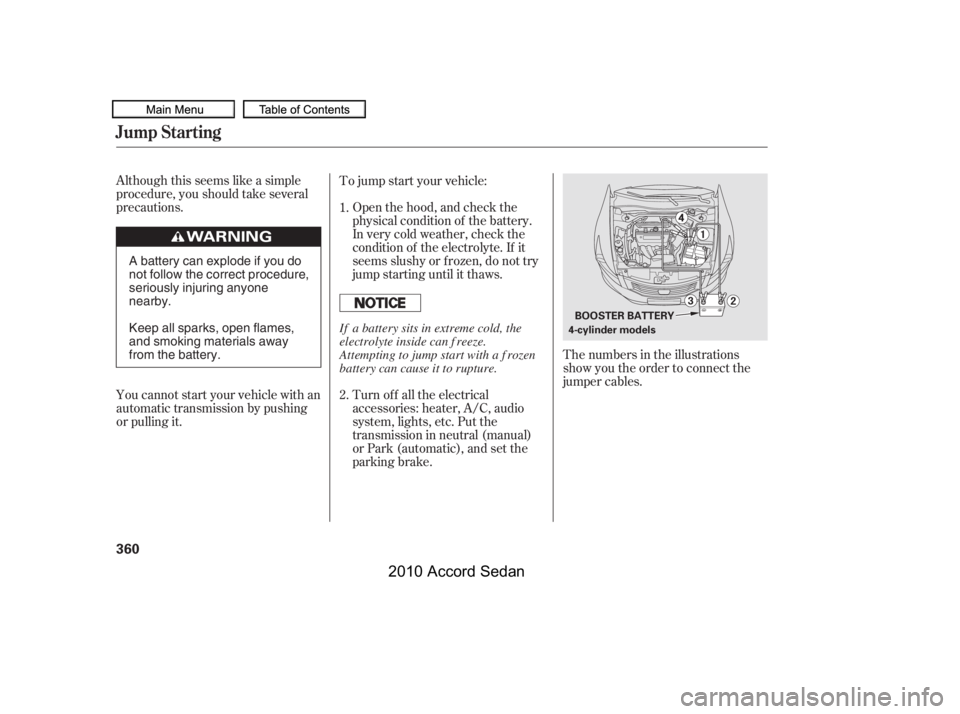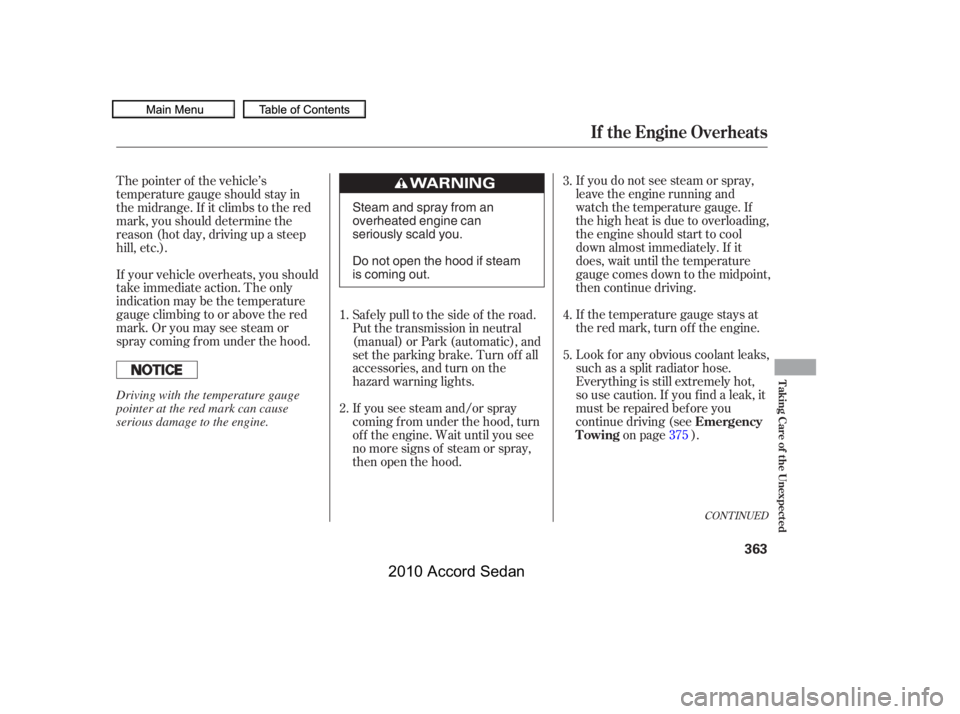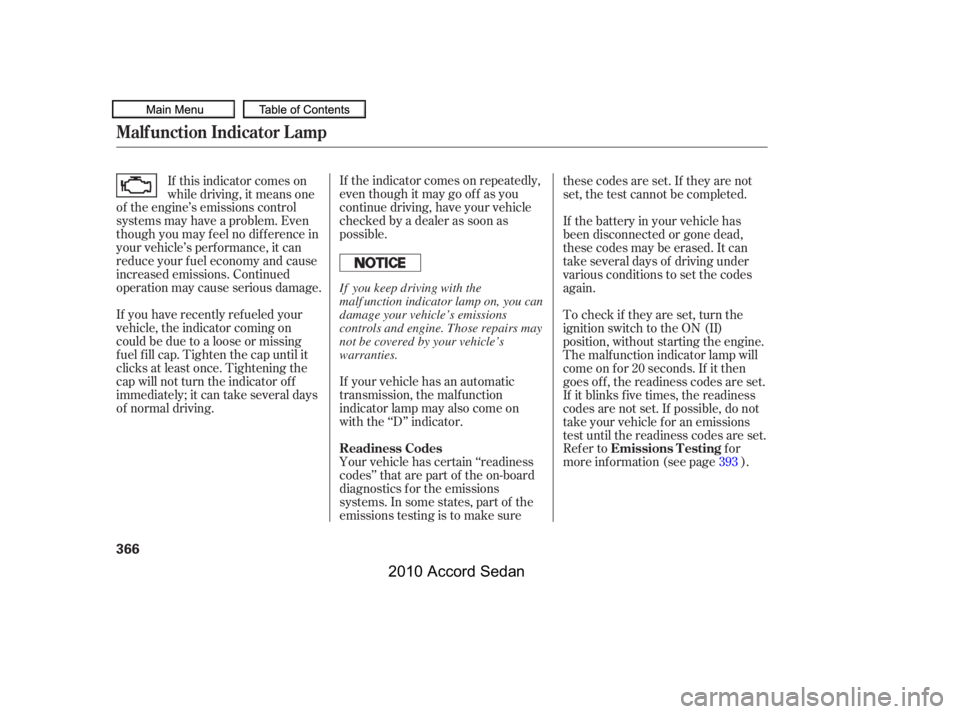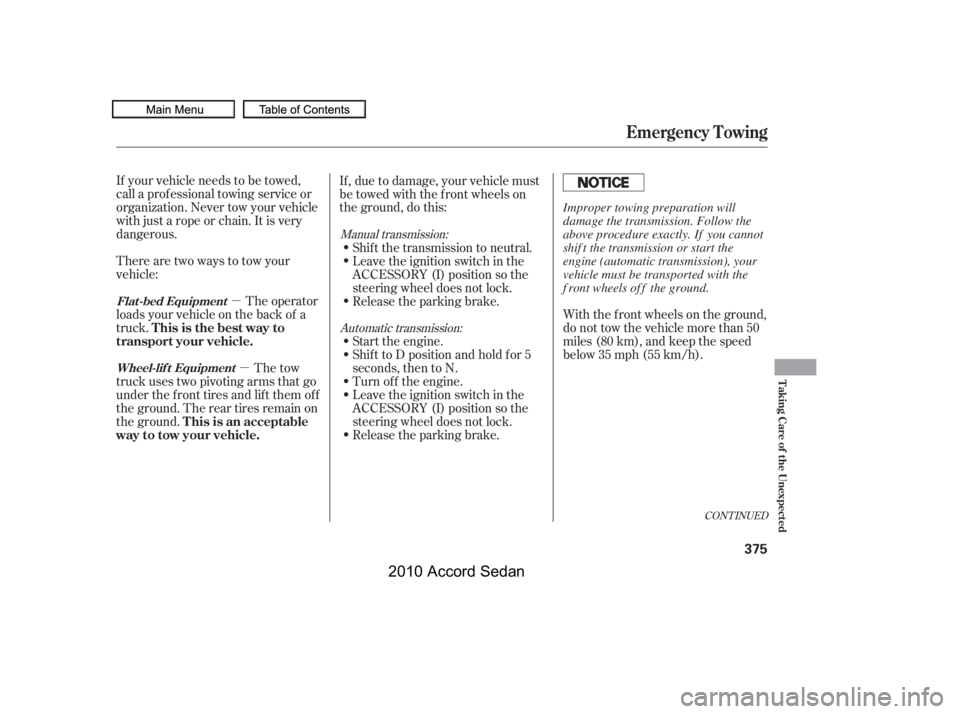Page 363 of 414

Although this seems like a simple
procedure, you should take several
precautions.Open the hood, and check the
physical condition of the battery.
In very cold weather, check the
condition of the electrolyte. If it
seems slushy or f rozen, do not try
jump starting until it thaws.
To jump start your vehicle:
Turn of f all the electrical
accessories: heater, A/C, audio
system, lights, etc. Put the
transmission in neutral (manual)
or Park (automatic), and set the
parking brake.
You cannot start your vehicle with an
automatic transmission by pushing
or pulling it.
The numbers in the illustrations
show you the order to connect the
jumper cables.
1.
2.
Jump Starting
360
BOOSTER BATTERY
4-cylinder models
A battery can explode if you do
not follow the correct procedure,
seriously injuring anyone
nearby.
Keep all sparks, open flames,
and smoking materials away
from the battery.
If a battery sits in extreme cold, the
electrolyte inside can f reeze.
Attempting to jump start with a f rozen
battery can cause it to rupture.
09/07/08 21:43:44 31TA5620_365
2010 Accord Sedan
Page 364 of 414
�´
�´
�µ
CONT INUED
Connect one jumper cable to the
positive ( ) terminal on your
battery. Connect the other end to
the positive ( ) terminal on the
booster battery.
Connect the second jumper cable
to the negative ( ) terminal on
the booster battery. Connect the
other end to the engine mounting
bolt (automatic) or the
transmission mounting bolt
(manual),asshown.Donot
connect this jumper cable to any
other part of the engine.
3.4.4-cylinder models
Jump Starting
T aking Care of t he Unexpect ed
361
V6 models BOOSTER BATTERY4-cylinder models with automatic transmission4-cylinder models with manualtransmission
�����—�����—�
���y�
����
��������y���
�)�����������y���������y
2010 Accord Sedan
Page 366 of 414

If you do not see steam or spray,
leave the engine running and
watch the temperature gauge. If
the high heat is due to overloading,
the engine should start to cool
down almost immediately. If it
does, wait until the temperature
gauge comes down to the midpoint,
then continue driving.
If the temperature gauge stays at
the red mark, turn off the engine.
Look f or any obvious coolant leaks,
such as a split radiator hose.
Everything is still extremely hot,
so use caution. If you f ind a leak, it
must be repaired bef ore you
continue driving (see
on page ).
The pointer of the vehicle’s
temperature gauge should stay in
the midrange. If it climbs to the red
mark, you should determine the
reason (hot day, driving up a steep
hill, etc.).
If your vehicle overheats, you should
take immediate action. The only
indication may be the temperature
gauge climbing to or above the red
mark. Or you may see steam or
spray coming f rom under the hood.
If you see steam and/or spray
coming f rom under the hood, turn
of f the engine. Wait until you see
no more signs of steam or spray,
then open the hood.
Saf ely pull to the side of the road.
Put the transmission in neutral
(manual) or Park (automatic), and
set the parking brake. Turn of f all
accessories, and turn on the
hazard warning lights.
1.
2.
3.
4.
5.
375
CONT INUED
Emergency
Towing
If theEngineOverheats
T aking Care of t he Unexpect ed
363
Steam and spray from an
overheated engine can
seriously scald you.
Do not open the hood if steam
is coming out.
Driving with the temperature gauge
pointer at the red mark can cause
serious damage to the engine.
09/07/08 21:43:53 31TA5620_368
2010 Accord Sedan
Page 369 of 414

If your vehicle has an automatic
transmission, the malf unction
indicator lamp may also come on
with the ‘‘D’’ indicator.
If the indicator comes on repeatedly,
even though it may go of f as you
continue driving, have your vehicle
checked by a dealer as soon as
possible.
If this indicator comes on
while driving, it means one
of the engine’s emissions control
systems may have a problem. Even
though you may f eel no dif f erence in
your vehicle’s perf ormance, it can
reduce your f uel economy and cause
increased emissions. Continued
operation may cause serious damage.
Your vehicle has certain ‘‘readiness
codes’’ that are part of the on-board
diagnostics f or the emissions
systems. In some states, part of the
emissions testing is to make sure
these codes are set. If they are not
set, the test cannot be completed.
If you have recently ref ueled your
vehicle, the indicator coming on
could be due to a loose or missing
f uel f ill cap. Tighten the cap until it
clicks at least once. Tightening the
cap will not turn the indicator of f
immediately; it can take several days
of normal driving.
If the battery in your vehicle has
been disconnected or gone dead,
thesecodesmaybeerased.Itcan
take several days of driving under
various conditions to set the codes
again.
To check if they are set, turn the
ignition switch to the ON (II)
position, without starting the engine.
The malf unction indicator lamp will
come on f or 20 seconds. If it then
goes of f , the readiness codes are set.
If it blinks f ive times, the readiness
codes are not set. If possible, do not
take your vehicle f or an emissions
test until the readiness codes are set.
Refer tofor
more information (see page ).393
Readiness CodesEmissions T esting
Malf unction Indicator L amp
366
If you keep driving with the
malf unction indicator lamp on, you can
damage your vehicle’s emissions
controls and engine. Those repairs may
not be covered by your vehicle’s
warranties.
�����—�����—�
���y�
����
��������y���
�)�����������y�������
�y
2010 Accord Sedan
Page 378 of 414

�µ
�µ
If your vehicle needs to be towed,
call a prof essional towing service or
organization. Never tow your vehicle
with just a rope or chain. It is very
dangerous.
The operator
loads your vehicle on the back of a
truck.
Therearetwowaystotowyour
vehicle:
If , due to damage, your vehicle must
be towed with the f ront wheels on
the ground, do this:
With the f ront wheels on the ground,
do not tow the vehicle more than 50
miles (80 km), and keep the speed
below35mph(55km/h).
The tow
truck uses two pivoting arms that go
under the f ront tires and lif t them of f
the ground. The rear tires remain on
the ground.
Release the parking brake.
Start the engine.
Shif t the transmission to neutral.
Leave the ignition switch in the
ACCESSORY (I) position so the
steering wheel does not lock.
Release the parking brake.
Shif t to D position and hold f or 5
seconds, then to N.
Turn of f the engine.
Leave the ignition switch in the
ACCESSORY (I) position so the
steering wheel does not lock.
Manual transmission:
Automatic transmission:
CONT INUED
Flat -bed Equipment
Wheel-lif t Equipment
T his is the best way to
transport your vehicle.
This is an acceptable
way to tow your vehicle.
Emergency Towing
T aking Care of t he Unexpect ed
375
Improper towing preparation will
damage the transmission. Follow the
above procedure exactly. If you cannot
shif t the transmission or start the
engine (automatic transmission), your
vehicle must be transported with the
f ront wheels of f the ground.
�����—�����—�
���y�
����
��������y���
�)�����������y���������y
2010 Accord Sedan
Page 382 of 414
The transmission number is on a
label on top of the transmission.
The engine number is stamped on
the f ront of the engine block.
Identif ication Numbers
Technical Inf ormation
379
ENGINE NUMBER
V6 models
AUTOMATIC TRANSMISSION NUMBER
ENGINE NUMBER
AUTOMATIC TRANSMISSIONNUMBER
MANUAL TRANSMISSION NUMBER
4-cylinder models
�����—�����—�
���y�
����
����
���y���
�)�����������y���������y
2010 Accord Sedan
Page 383 of 414

�µ�µ
�Î
�Î
�Î�Î�Î
�Î
�Î �Î
Specif ications (4-cylinder models)
380
DimensionsSeating Capacities
Capacities
Weights
Air Conditioning
Engine
110.2 in (2,800 mm) 62.6 in (1,590 mm)
LengthWidthHeightWheelbaseTrack
194.1 in (4,930 mm)72.7 in (1,847 mm)58.1 in (1,475 mm)
4.8 US qt (4.5)2.6 US qt (2.5)
6.9 US qt (6.5)2.6 US qt (2.5)2.1 US qt (2.0)2.0 US qt (1.9)5.4 US qt (5.1)4.0 US qt (3.8)4.2 US qt (4.0)
1.88 US gal (7.1)1.90 US gal (7.2)
1.56 US gal (5.9)1.59 US gal (6.0)
523
62.2 in (1,580 mm)
TotalFrontRear
Fuel tank
Engine coolant
Engine oil
Manual trans- mission fluidAutomatictransmissionfluidWindshieldwasherreservoirIncluding the coolant in the reserve tank and that remaining in theengineReserve tank capacity: 0.180 US gal (0.68)Excluding the oil remaining in the engine
Gross vehicle weight rating See the certification label attachedto the driver’s doorjamb.
Refrigerant typeCharge quantityLubricant type
HFC-134a (R-134a)14.1 15.9 oz (400 450 g)ND-OIL8
Water cooled 4-strokeDOHC i-VTEC 4-cylindergasoline engine3.43 x 3.9 in (87.0 x 99.0 mm)144 cu-in (2,354 cm)10.5 : 1ILZKR7B11SSXU22HCR11S
Type
BorexStroke DisplacementCompression ratioSpark plugs (U.S.)
Spark plugs (Canada)SXU22HCR11S ILZKR7B11SDILZKR7A11GS
18.5 US gal (70.0)Approx.
ChangeManual AutomaticTotalManualAutomatic
1:
2:
NGK: DENSO:
ChangeIncluding filterWithout filterTotalChangeTotalChangeTotal
U.S. Canada
Front/Rear
ULEV PZEV
1: 2: EX,EX-L
NGK:NGK:DENSO:
LX, LX-P1
2
1 2
09/07/08 21:45:28 31TA5620_385
2010 Accord Sedan
Page 385 of 414

�µ�µ
�Î
�Î
�Î
�Î
Specif ications (V6 models)
382
DimensionsSeating Capacities
Capacities
Weights
Air Conditioning
Engine
110.2 in (2,800 mm)
Length WidthHeightWheelbaseTrack
194.3 in (4,936 mm)72.7 in (1,847 mm)58.1 in (1,475 mm)
62.2 in (1,580 mm)
Total FrontRear
523
Fuel tank
Engine coolantEngine oil
Automatic transmissionfluidWindshieldwasherreservoir
1.74 US gal (6.6)2.27 US gal (8.6)
4.5 US qt (4.3)
5.3 US qt (5.0)3.5 US qt (3.3)7.9 US qt (7.5)
2.6 US qt (2.5)4.8 US qt (4.5)
Including the coolant in the reserve tank and that remaining in theengineReserve tank capacity:Excluding the oil remaining in the engine0.180 US gal (0.68)
Gross vehicle weight rating See the certification label attachedto the driver’s doorjamb.
Refrigerant typeCharge quantityLubricant type
HFC-134a (R-134a)14.1 15.9 oz (400 450 g)ND-OIL8
3.50 x 3.66 in (89.0 x 93.0 mm)212 cu-in (3,471 cm)10.5 : 1ILZKR7B11SXU22HCR11
18.5 US gal (70.0)
Water cooled 4-strokeSOHC i-VTEC 6-cylinder (V6)gasoline engine
4.2 US qt (4.0)
Type
BorexStroke DisplacementCompression ratioSpark plugs (U.S.)
Spark plugs (Canada)ILZKR7B11SXU22HCR11
Approx.
1:
2:
ChangeIncluding filter Without filterTotalChangeTotal
U.S. Canada
Change Total
Front/Rear
NGK:DENSO:NGK:DENSO:
2
1
�����—�����—�
���y�
����
��������y���
�)�����������y���������y
2010 Accord Sedan